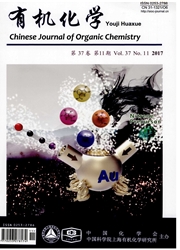

 中文摘要:
中文摘要:
In recent years, considerable efforts have been devoted to the development of systems in which C60 is covalently linked to an electron donor.[1] Studies[2] on intermolecular photoinduced electron transfer between C60 and triphenyl amine show that triphenyl amine is a good donor. It is envisaged that the use of donor segments consisting of either pyrrole/aniline may extend the lifetime of charge-separated state.[3] Since Gedye[4] demonstrated that many organic reactions can be conducted rapidly under microwave irradiation, here we have successfully synthesized five new fulleropyrrolidines containing triphenyl amine or thiophene dyads under microwave irradiation, which are different from traditional heating. The determination of structures of these fulleropyrrolidines is in progress. On the other hand, we have studied the geometry, electronic structures and frontier orbitals of these N-methyl-pyrrolo[3,4]C60 derivatives by using AM1semiempirical quantum calculation method. The results indicate that there exists strong intramolecular electron transfer in them.……
 同期刊论文项目
同期刊论文项目
 同项目期刊论文
同项目期刊论文
 期刊信息
期刊信息
